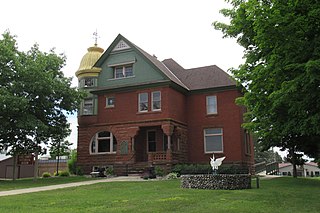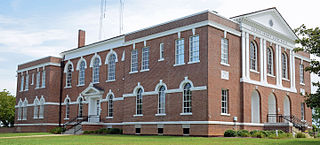
This is intended to be a complete list of properties and districts listed on the National Register of Historic Places in Orleans County, New York. The locations of National Register properties and districts may be seen in a map by clicking on "Map of all coordinates". Two listings, the New York State Barge Canal and the Cobblestone Historic District, are further designated a National Historic Landmark.

The Crow Wing Historic County Courthouse, in Brainerd, Minnesota, United States, is a Beaux-Arts courthouse built in 1920. The building, along with its adjoining jail, are listed on the National Register of Historic Places.

The Houston County Courthouse and Jail, located at 304 Marshall Street South in Caledonia, Houston County in the U.S. state of Minnesota, consists of a Romanesque stone courthouse featuring a prominent center tower, built in 1883 and an Italianate stone jail and sheriff residence built in 1875. Both were designed by C. G. Maybury & Son of Winona.

Bergen County, New Jersey had a series of court houses. The current one stands in Hackensack, New Jersey.

New York's historic Putnam County Courthouse is located on Gleneida Avenue across from the eastern terminus of NY 301 in downtown Carmel, the county seat, overlooking Lake Gleneida. First built in 1814, two years after the county itself was established, it is the second-oldest county courthouse still in use in the state after Fulton County's.

The Renville County Courthouse and Jail is a historic building located at 500 East DePue Avenue in Olivia, Minnesota, United States; the seat of Renville County. It was constructed in 1902.

This is a list of the National Register of Historic Places listings in Todd County, Minnesota. It is intended to be a complete list of the properties and districts on the National Register of Historic Places in Todd County, Minnesota, United States. The locations of National Register properties and districts for which the latitude and longitude coordinates are included below, may be seen in an online map.

The Wailuku Civic Center Historic District is a group of four historic buildings and one non-contributing property in Wailuku, Maui Hawaii that currently house the governmental offices of both the County of Maui and the State of Hawaii. The historic buildings were built during a time span from 1901 to 1931. They incorporate several architectural styles and two of the four historic buildings were designed and built by Hawaii-based architect C.W. Dickey. The non-contributing property houses most of the County of Maui's main offices.

The Dickinson County Courthouse and Jail is an historic complex of governmental buildings located at 700 South Stephenson Avenue in Iron Mountain, Michigan. On May 15, 1980, the complex was added to the National Register of Historic Places.

The Van Wert County Courthouse is a historic governmental building in downtown Van Wert, Ohio, United States. Located at 121 E. Main Street, the courthouse is a Second Empire structure built in 1876. It is Van Wert County's third courthouse: when the county was established, the village of Willshire was designated the county seat; Van Wert was made the seat in 1838, and a courthouse-and-jail complex was built in that community in the following year.

The Luce County Sheriff's House and Jail was originally built as a correctional facility and government building at 411 West Harrie Street in Newberry, Michigan, United States. It was listed on the National Register of Historic Places in 1982 and designated a Michigan State Historic Site in 1975.

Fremont D. Orff (1856-1914) was an American architect.

The Gogebic County Courthouse is a government building located on North Moore Street in Bessemer, Michigan. It was listed on the National Register of Historic Places in 1981 and designated a Michigan State Historic Site in 1971.

The Menominee County Courthouse is a government building located on Tenth Avenue between Eighth and Tenth Streets in Menominee, Michigan. It was listed on the National Register of Historic Places in 1975 and designated a Michigan State Historic Site in 1974.

The Telfair County, Georgia Courthouse in McRae-Helena was built in 1934 using the walls of the previous courthouse, lost to fire earlier that year. It was designed by architects Dennis & Dennis. The nearby Telfair County Jail was built in 1902. The courthouse and jail were added to the National Register of Historic Places in 1995.

The Grey Eagle Village Hall is a multipurpose municipal building in Grey Eagle, Minnesota, United States. It was built in 1934 as a federally funded New Deal project to create jobs during the Great Depression. It originally contained local government offices, a fire station, and a community auditorium. The building was listed on the National Register of Historic Places in 1985 for having local significance in the themes of architecture and politics/government. It was nominated for being a superlative example of the public works projects of the Civil Works Administration.

The Big Stone County Courthouse in Ortonville, Minnesota is the center of government for Big Stone County, Minnesota. The county was established by the Minnesota Legislature in 1862, but the government was not organized until 1873, when Governor Horace Austin appointed three county commissioners. They did nothing, so Governor Cushman Kellogg Davis appointed three replacement commissioners in 1874. The county seat was established at Ortonville in 1874 and three elected commissioners took office in the beginning of 1877. The organization was challenged in court, and the Minnesota Supreme Court ruled that the county had not properly been organized. The county was declared organized in 1881 by the Minnesota Legislature. The first courthouse, a wood-frame structure, was built in October 1882, but was destroyed by fire on October 31, 1885. A new wood-frame courthouse was built in 1886, and the county later built a granite jail building in 1895.

The Stearns County Courthouse is the seat of government for Stearns County in St. Cloud, Minnesota, United States. The Beaux-Arts style building was constructed in 1921 to replace Stearns County's original 1864 courthouse. It stands in a prominent square in downtown St. Cloud, flanked by other government buildings. A Prairie School style jail was built to the northeast in 1922, and the two buildings were listed as the Stearns County Courthouse and Jail on the National Register of Historic Places in 1982 for having local significance in the themes of architecture and politics/government. They were nominated for being prominent symbols of Stearns County government. The 1922 jail building was demolished in 1987.

The Sibley County Courthouse and Sheriff's Residence and Jail are two adjacent government buildings in Gaylord, Minnesota, United States. They were built in 1916 and serve as the seat of government for Sibley County. An annex to the courthouse was added in 1976.



























